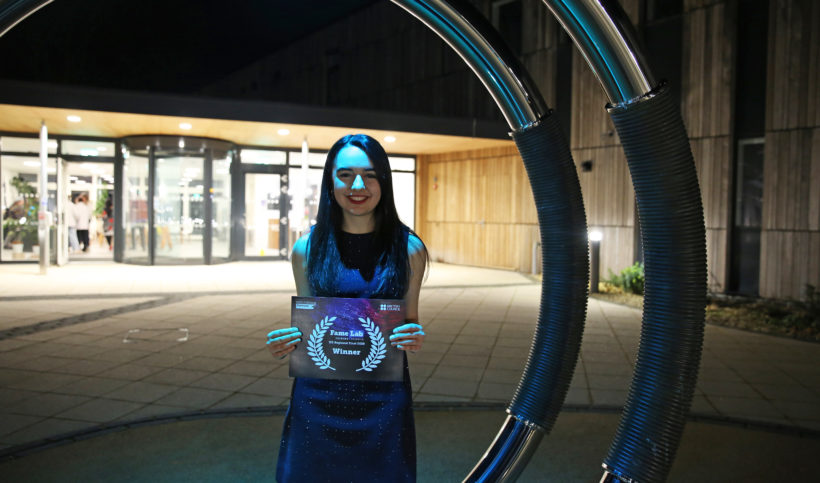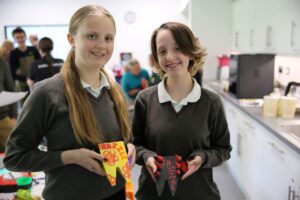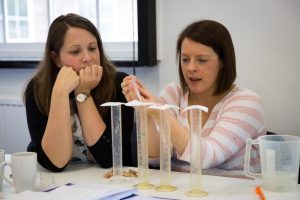Oxford champion will go to FameLab UK final
Tuesday 10th March 2020

We celebrated the launch of British Science Week with the Oxford FameLab Regional Final 2020 at our new Science Oxford Centre Theatre at Stansfeld Park. Our eight brave and brilliant finalists battled it out on stage but it was Maria Violaris who won the day and was crowned the queen of science chatter!
With just a few minutes to explain a science concept or idea, Maria talked about entropy and speculated about the beginning of the universe while scrambling an egg on stage! A fourth-year physics master’s student at the University of Oxford, she began performing hip-hop routines aged 13 and will now go on to compete in the UK final at the Cheltenham Science Festival in June.
The contestants performed their three-minute skits in front of a panel of judges that included Professor Irene Tracey, Head of the Department of Clinical Neurosciences at the University of Oxford, Oxford astronomer Professor Patrick Roche, and science education consultant Lynne Pebworth. The evening was compered by Dr Lucy Rogers – science author, inventor and judge on BBC2’s Robot Wars. Maria gave a fascinating and hilarious talk which wowed the judges – and the audience – and sent her straight through to the UK final.
Rowena Fletcher Wood, who organised the 2020 heats for Science Oxford, went along for the evening despite having given birth two weeks ago – and, as tradition dictates, squeezed her honker at every 3-minute mark and wrote one of her infamous blogs – a fitting tribute for International Women’s Day weekend! Read on…
“I might be on maternity leave but that wasn’t going to stop me from having a good time and my 12-day old daughter, Robin, attending her first science event: FameLab. I wore my periodic table shoes, Robin wore rockets and dinosaurs, and my husband wore Robin in a sling.
Bringing Robin turned out to be more topical than I thought. Danielle Perro (second year DPhil student studying in the Nuffield Department of Women’s and Reproductive Health) took us on the bleak journey of the unfertilised egg, or the happy honeymoon of a fertilised one – a story that ends with menstruation, or, as she called it “lady time” which had an accompanying dance.
And eggs came up more than once: Maria Violaris scrambled one on stage as she demonstrated the trajectory of entropy (a measure of chaos) – from a state of order to irreversible disorder and speculated on the birth of the universe. In fact, she concluded, it is more likely we are a floating brain than that the physical universe exists…
Talking of randomness, just as we thought we were on a roll, Tom Gregory opened with a popular English conversation topic: the weather. With the assistance of two large dice, he demonstrated how he could strive to be the perfect dice roller, and still random chance, satellite resolution, computer rounding and human errors could perturb his model and ultimately lead to disaster.
Is a pregnancy test a disaster or a celebration? Hanene Ali-Boucetta (a lecturer in Pharmaceutical Nanoscience, University of Birmingham) introduced us to the nonsense that is “nanotoxicity”, when nanoparticles are so numerous and varied (her favourite nanoparticles, by the way, are carbon nanotubes. And it’s gold nanoparticles that work inside pregnancy tests to give those life-changing little pink lines.
So nanoparticles may not be dangerous… but what about potatoes? Maleeha Bari (a medication safety pharmacist and pharmacy flu lead for the Mental Health Trust in Oxford) titillated us with a warning: under the right conditions, your potato can grow spores and kill you. This is botulism, a disease caused by the same bacterial toxins used in botox. And if that fact doesn’t make you smile, what will?
Other elements of life could be found in Bella Boulderstone’s (MSc Archaeological Science student at Oxford University) star talk. Whilst she only blew up a balloon, our sun could do something rather different: shrink and cool to a white dwarf to make carbon, nitrogen, and oxygen… (the elements we’re made of), or violently implode to form black holes.
If that sounds a bit heavy-going for you, perhaps you can answer Mike Richardson’s (PhD psychology student, researching sensation and perception at the University of Bath) question: which is heaviest, red or yellow? “Colours don’t have mass,” he reminds us, but the fact that we’re all so sure which we’d choose is an example of cross-modal thinking.
You may not understand your brain, but Nicola Hall (a molecular biology researcher in the university department of psychiatry) is writing to one. In her “letter to a brain” monologue, she marvels at the molecules that send messages between cells and the treatments that could be developed if only we spoke their molecular language.
As the judges pontificated, Matt Tompkins entertained us with magic tricks that played with our sense of perception. Even Robin was impressed: in fact, after sleeping through most of the evening, she came awake for long enough to scream out when he asked for volunteers. Luckily, she wasn’t chosen. But that’s the great thing about FameLab: whilst most of the audience are die-hard science fans like myself, it can be for everyone. As the woman behind me said to her friend, “As a complete non-scientist, I was engrossed.”
Famelab UK aims to find the new voices of science and engineering. People with a gift for creating an engaging story around either their own scientific research or an area of science they find interesting are given just three minutes to win over a panel of judges and the audience. Special mention goes to runner up, Tom Gregory, a maths PhD student at Imperial College, London specialising in the Mathematics of Planet Earth. We wish Maria the best of luck at the UK final in June, it would be great to have an Oxford winner!



